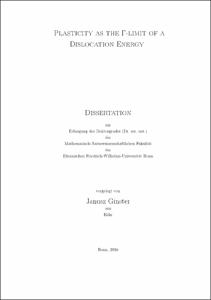Plasticity as the Γ-limit of a Dislocation Energy

Plasticity as the Γ-limit of a Dislocation Energy

| dc.contributor.advisor | Müller, Stefan | |
| dc.contributor.author | Ginster, Janusz | |
| dc.date.accessioned | 2020-04-23T18:54:51Z | |
| dc.date.available | 2020-04-23T18:54:51Z | |
| dc.date.issued | 19.07.2017 | |
| dc.identifier.uri | https://hdl.handle.net/20.500.11811/7110 | |
| dc.description.abstract | In this thesis, we derive macroscopic crystal plasticity models from mesoscopic dislocation models by means of Γ-convergence as the interatomic distance tends to zero. Crystal plasticity is the effect of a crystal undergoing an irreversible change of shape in response to applied forces. At the atomic scale, dislocations --- which are local defects of the crystalline structure --- are considered to play a main role in this effect. We concentrate on reduced two-dimensional models for straight parallel edge dislocations. Firstly, we consider a model with a nonlinear, rotationally invariant elastic energy density with mixed growth. Under the assumption of well-separateness of dislocations, we identify all scaling regimes of the stored elastic energy with respect to the number of dislocations and prove Γ-convergence in all regimes. As the main mathematical tool to control the non-convexity induced by the rotational invariance of the energy, we prove a generalized rigidity estimate for fields with non-vanishing curl. For a given function with values in the set of 2x2 matrices, the estimate provides a quantitative bound for the distance to a specific rotation in terms of the distance to the set of rotations and the curl of the function. The most important ingredient for the proof is a fine estimate which shows that in two dimensions an integrable vector-valued function f can be decomposed into two parts belonging to certain negative Sobolev spaces with critical exponent such that corresponding estimates depend only on div f and the integral of |f|. This is a generalization of an estimate due to Bourgain and Br'ezis. Secondly, we consider a dislocation model in the setting of linearized elasticity. The main difference to the first case above and existing literature is that we do not assume well-separateness of dislocations. In order to prove meaningful lower bounds, we adapt ball construction techniques which have been used successfully in the context of the Ginzburg-Landau functional. The building block for this technique are good lower bounds on annuli. In contrast to the vortices in the Ginzburg-Landau model, in the setting of linear elasticity, a massive loss of rigidity can be observed on thin annuli which leads to inadequate lower bounds. Hence, our analysis focuses on finding thick annuli which carry almost all relevant energy. | en |
| dc.language.iso | eng | |
| dc.rights | In Copyright | |
| dc.rights.uri | http://rightsstatements.org/vocab/InC/1.0/ | |
| dc.subject | Calculus of Variations | |
| dc.subject | Γ-Convergence | |
| dc.subject | Dislocations | |
| dc.subject | Plasticity | |
| dc.subject | Rigidity | |
| dc.subject.ddc | 510 Mathematik | |
| dc.title | Plasticity as the Γ-limit of a Dislocation Energy | |
| dc.type | Dissertation oder Habilitation | |
| dc.publisher.name | Universitäts- und Landesbibliothek Bonn | |
| dc.publisher.location | Bonn | |
| dc.rights.accessRights | openAccess | |
| dc.identifier.urn | https://nbn-resolving.org/urn:nbn:de:hbz:5n-46126 | |
| ulbbn.pubtype | Erstveröffentlichung | |
| ulbbnediss.affiliation.name | Rheinische Friedrich-Wilhelms-Universität Bonn | |
| ulbbnediss.affiliation.location | Bonn | |
| ulbbnediss.thesis.level | Dissertation | |
| ulbbnediss.dissID | 4612 | |
| ulbbnediss.date.accepted | 21.12.2016 | |
| ulbbnediss.institute | Mathematisch-Naturwissenschaftliche Fakultät : Fachgruppe Mathematik / Institut für angewandte Mathematik | |
| ulbbnediss.fakultaet | Mathematisch-Naturwissenschaftliche Fakultät | |
| dc.contributor.coReferee | Conti, Sergio |
Dateien zu dieser Ressource
Das Dokument erscheint in:
-
E-Dissertationen (4430)




